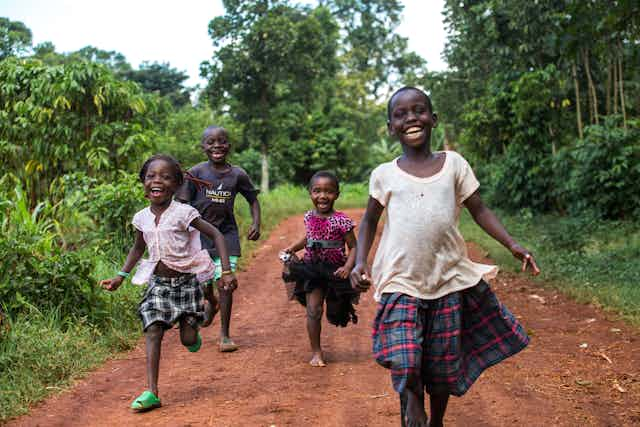Children’s health and development depend on how much time they spend doing physical activity, being sedentary and sleeping.
Research on movement behaviours in children is essential. It helps us to understand what influences these behaviours, and their contribution to health and development.
Most evidence on movement behaviours comes from high-income countries. Here children have different lifestyles, environments and cultures from those in low- and middle-income countries. For example, children in African countries face different challenges in achieving healthy levels of physical activity and sleep. Safety, transport, infrastructure, culture, climate, nutrition, and different levels and types of screen time exposure may all present challenges.
Africa, as a continent, contributes less than 1% of research worldwide. This means over 16% of the world’s population has been excluded from the research.
The international SUNRISE study, which we are part of, aims to bridge this gap. It conducts studies on movement behaviour in collaboration with researchers in several African countries, including Ethiopia, Nigeria and South Africa, where we are based. We bring a collective expertise across disciplines such as public health, physiotherapy and child development.
SUNRISE findings so far show that the proportion of children in low- and middle-income countries meeting recommendations for movement behaviours is low, compared to high-income countries. This highlights the need for research and intervention in Africa.
But since the beginning of this study we have faced a wide range of challenges. In each country, the target number of children for the study is around 1,000. Researching their movement behaviour requires technology.
The challenges include access to devices to track movement, the lack of awareness of such tools and what they do, difficulty in securing funds, and institutional challenges.
Solutions include local collaboration, reducing financial barriers, developing new low-cost devices, and using contextually relevant methods. The following sections describe the challenges and possible solutions in detail.
Challenges
Access to devices
Accelerometers are a type of digital wearable device, similar to Fitbits and smart watches. But they measure movement more accurately than commercially available devices. This is why they are more commonly used in research. These devices are generally more expensive because they are “research-grade”, and upwards of US$250 each (before software and delivery). This is a major challenge for those of us working in African countries, as at least 50 devices would be needed to conduct large scale studies like SUNRISE. There is no local manufacturer or distributor of accelerometer devices. Researchers need a legal licence to import or export them.
The SUNRISE study is able to loan devices. But exorbitant customs and shipping charges for moving this equipment to and between African countries makes sharing difficult – even when it’s only for research. This leads to unnecessary costs and delays, which means Africa gets left behind in this scientific field.
Lack of awareness about the benefits of accelerometers
These devices are often novel in African settings. Some parents and caregivers in our study areas have been sceptical about using them. For example, caregivers have asked whether the devices attract lightning, or whether they have some physical effect on the body. This may lead to another challenge in recruiting sufficient participants for the study. And data collection can take a long time when the shortage of devices is added to the time to get local buy-in.
Difficulty in securing funds
SUNRISE study researchers in Africa battle to get funding. They rely on highly competitive international funding, which seldom prioritises movement behaviour research in young children. It costs a lot to attend conferences internationally and to publish research in reputable academic journals. Open access journal fees can even exceed the monthly salary of a research assistant in an African country.
Institutional challenges
Within African research institutions, another challenge is how to build capacity. Few research institutes focus on movement behaviours in Africa. Accelerometer data is often complex to manage, and needs trained staff. High-income countries typically have access to support staff and students who can assist with this. This is not the case in many African countries. So it is difficult to conduct high-quality research and translate it into policy and practice.
Possible solutions
A possible solution is to collaborate with local partners and stakeholders to identify the most appropriate devices for each context and population.
All stakeholders, including local government and non-government organisations, ought to remove barriers so that the researchers can focus on the quality of evidence to inform policy and practice that is anchored to the local context.
Establishing some type of research equipment hub in Africa would go some way to help. But even moving equipment within Africa is not easy. Governments should consider waiving import and export charges for research equipment. The development of low-cost devices that can be produced and used efficiently in Africa is the best way forward.
Researchers in Africa could also examine other new data collection methods that are customised to the local context. Qualitative research (interviews and focus groups) can provide valuable insights into the factors that influence movement behaviours in different contexts. These insights are vital for the development of measurement tools and interventions that are culturally appropriate and effective.
Conclusion
There are many other pressing needs in Africa. But the contribution of movement behaviours to population health and development is significant, particularly as there is growing evidence of the global economic costs of physical inactivity. We need local research on these behaviours, starting in the early years, when patterns of behaviour are established.
Without addressing barriers to robust research, researchers in this region will continue to lag behind in this field.
This means that we lose opportunities to learn how to promote movement behaviours that support health and development, thus setting children on the best path for life.

